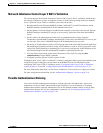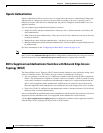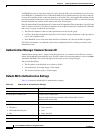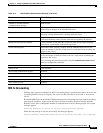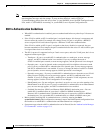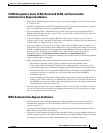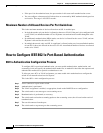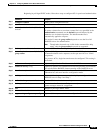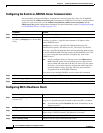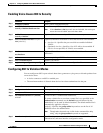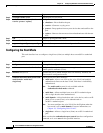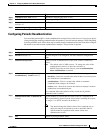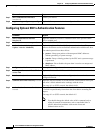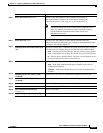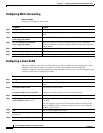
13-35
Cisco IE 2000 Switch Software Configuration Guide
OL-25866-01
Chapter 13 Configuring IEEE 802.1x Port-Based Authentication
How to Configure IEEE 802.1x Port-Based Authentication
Beginning in privileged EXEC mode, follow these steps to configure 802.1x port-based authentication:
Command Purpose
Step 1
configure terminal Enters global configuration mode.
Step 2
aaa new-model Enables AAA.
Step 3
aaa authentication dot1x {default}
method1
Creates an 802.1x authentication method list.
To create a default list to use when a named list is not specified in the
authentication command, use the default keyword followed by the
method to use in default situations. The default method list is
automatically applied to all ports.
For method1, enter the group radius keywords to use the list of all
RADIUS servers for authentication.
Note Though other keywords are visible in the command-line help
string, only the group radius keywords are supported.
Step 4
dot1x system-auth-control Enables 802.1x authentication globally on the switch.
Step 5
aaa authorization network {default}
group radius
(Optional) Configures the switch to use user-RADIUS authorization for
all network-related service requests, such as per-user ACLs or VLAN
assignment.
For per-user ACLs, single-host mode must be configured. This setting is
the default.
Step 6
radius-server host ip-address (Optional) Specifies the IP address of the RADIUS server.
Step 7
radius-server key string (Optional) Specifies the authentication and encryption key used between
the switch and the RADIUS daemon running on the RADIUS server.
Step 8
interface interface-id Specifies the port connected to the client to enable for 802.1x
authentication, and enter interface configuration mode.
Step 9
switchport mode access (Optional) Sets the port to access mode only if you configured the
RADIUS server in Step 6 and Step 7.
Step 10
authentication port-control auto Enables 802.1x authentication on the port.
Step 11
dot1x pae authenticator Sets the interface Port Access Entity to act only as an authenticator and
ignore messages meant for a supplicant.
Step 12
end Returns to privileged EXEC mode.
Step 13
show authentication Verifies your entries.
Step 14
copy running-config startup-config (Optional) Saves your entries in the configuration file.



